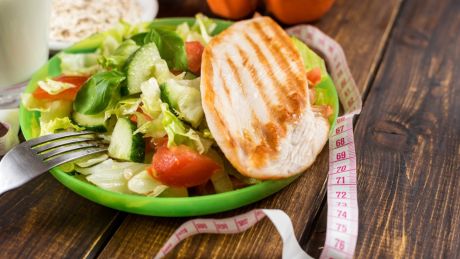Lose Weight With Portion Control
Don’t ditch entire food groups, just eat the right amount of them

People are prepared to try almost any change to their diet in order to lose weight, but when it comes to one measure that will definitely help – namely eating smaller portions – many are unwilling to make the sacrifice.
Research conducted by the British Heart Foundation (BHF) in 2013 found that portion sizes have become steadily larger in the UK over the past couple of decades and that people pay little regard to the suggested serving size on food packaging.
The BHF found that, compared with suggested portion sizes outlined by the government in 1993, an individual shepherd’s pie ready meal was twice the size in 2013 while a chicken curry ready meal was 50% bigger, as was the suggested portion size from a family pack of crisps. When the BHF asked people to pour out 30g of cornflakes, the suggested portion size, 88% of people poured out a larger serving.
In 2015, a review of 61 studies published in the Cochrane Database of Systematic Reviews concluded that if Brits cut outsized portions from their diet it would reduce the amount of calories they get from food daily by 12-16%, or up to 279 calories.
While cutting out entire food groups has become a common approach to dieting, evidence indicates that having smaller portions is a smarter bet for long-term weight loss.
“We all like different types of food and drink and telling someone to potentially restrict eating a food or food type they love is fundamentally unsustainable,” says Julian Gaine, creator of MealKitt, a portion control container that shows how much of each type of food you should eat.
“Also, human beings need a balanced diet with a complex array of macro- and micronutrients. Eliminating foods can lead to a deficiency in important nutrients.
Get the Coach Newsletter
Sign up for workout ideas, training advice, reviews of the latest gear and more.
“By including all the main food groups in your diet together with the foods you love in the correct portions, you still get all the necessary nutrients and it becomes a much more sustainable way to manage weight.”
You can follow the instructions on packets to get an idea of how large a portion of food should be, but it can be a bit of a faff to translate metric measurements to the plate exactly. If you want to eyeball your portion sizes, aim for a deck of cards size for pieces of lean meat, and a closed fist of carbs (or three heaped tablespoons).
While it can feel slightly uninspiring to dish out your food into various trays, the MealKitt tray will give a more exact guide to how much of each type of food you should eat if you’re trying to lose, gain or maintain weight.
If the portion sizes mentioned above sound tiny to you, that’s probably an indication you've been gorging on massive servings up until now, so it might take a little time to adjust to the smaller sizes.
“Generally with my clients I have noticed that it [portion control] becomes easier after 14 days and then almost normal after 28 days,” says Gaine.
You can also help your body adjust by eating more of the foods that aren’t restricted by portion sizes. Admittedly you will need to like green veg for this to be of use.
“There are also little tips and tricks to help curb hunger, such as filling up with ‘free’ foods including greens or drinking plenty of water,” says Gaine.
“Also, eating more good-quality fats and fibrous foods will help you feel fuller for longer.”
RECOMMENDED: The Meal Plan That Will Get You Lean In 4 Weeks
4 Tips For Better At Portion Control
1. Know numbers
In a 2017 study, subjects eating the same breakfast as another group ate more calories throughout the day when they believed their breakfast was less substantial. Keep track of what you eat, and you’ll avoid unnecessary calories.
2. Use your hand
“Rather than count calories, use your hands as a guideline to rough portions,” says Precision Nutrition coach Brian St Pierre. “Two fists of veg, two palms of protein, cupped hands of carbs and thumbs of fat will do it.”
3. Check your oil
“You don’t have to weigh every blueberry you eat, but oil is calorific enough to warrant being measured properly,” says nutritionist Jess Wolny. “Just a splash can add 100 calories – keep your measuring spoons handy.”
4. Pack snacks
Partition your food and you’ll force yourself to pay attention when you open a new box, bag or Tupperware. In a US study, volunteers given one big bag of snacks ate 20% more than those given the same amount of food divided into four.

Nick Harris-Fry is a journalist who has been covering health and fitness since 2015. Nick is an avid runner, covering 70-110km a week, which gives him ample opportunity to test a wide range of running shoes and running gear. He is also the chief tester for fitness trackers and running watches, treadmills and exercise bikes, and workout headphones.









